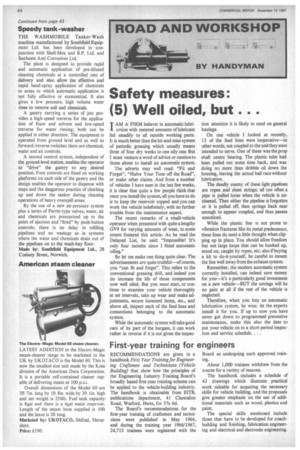Safety measures: (5) Well oiled, but . .
Page 46

If you've noticed an error in this article please click here to report it so we can fix it.
T AM A FIRM believer in automatic lubri1 cation with metered amounts of lubricant fed steadily to all outside working parts. It is much better than the hit-and-miss system of periodic greasing which usually means three of four dry weeks to one oily one. But I must venture a word of advice or caution to those about to install an automatic system.
The adverts may well read: "Fit and Forget", "Halve Your Time off the Road", or make other claims. And from a number of vehicles I have seen in the last few weeks, it is clear that quite a few people think that once you install the system, all you have to do is to keep the reservoir topped and you can work the vehicle indefinitely, with no further trouble from the maintenance aspect.
The recent remarks of a small-vehicle operator when presented with quite a lengthy GV9 for varying amounts of wear, to some extent fostered this article. As he read the Delayed List, he said: "Impossible! It's only four months since I fitted automatic oiling."
So let me make one thing quite clear. The advertisements are quite truthful—of course, you "can fit and forget". This.refers to the conventional greasing drill, and indeed you do increase the life of those components now well oiled. But you must start, or continue to examine your vehicle thoroughly at set intervals, take up wear and make adjustments, secure loosened items, etc., and above all, inspect each of the feed lines and connections belonging to the automatic system.
While the automatic system will take good care of its part of the bargain, it can work rather in reverse if it is not given the inspec tion attention it is likely to need on general haulage.
On one vehicle I looked at recently, 13 of the feed lines were inoperative—in other words, not coupled to the unit they were intended to serve. One of these was the prop shaft centre bearing. The plastic tube had been pulled out some time back, and was doing no more than dribble oil down the housing, leaving the actual ball race without lubrication.
The deadly enemy of these light pipelines are ropes and sheet strings; all too often a pipe is pulled loose when the vehicle is unsheeted. Then either the pipeline is forgotten or it is pulled off, then springs back near enough to appear coupled, and thus passes unnoticed.
While the plastic line is not prone to vibration fractures like its metal predecessor, these lines do need a little thought when clipping up in place. You should allow freedom but not large loops that can be hooked up, stood on, caught by ropes, etc; also if buying a kit to do-it-yourself, be careful to mount the line well away from the exhaust system.
Remember, the modern automatic system correctly installed, can indeed save money for you—it's a particularly good investment on a new vehicle—BUT the savings will be no gain at all if the rest of the vehicle is neglected.
Therefore, when you buy an automatic lubrication system, be wise: let the experts install it for you. If up to now you have never got "down to programmed preventive maintenance, make this also the date to put your vehicle on to a short-period inspection and service schedule. .












































































































